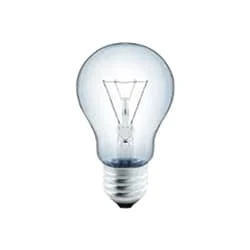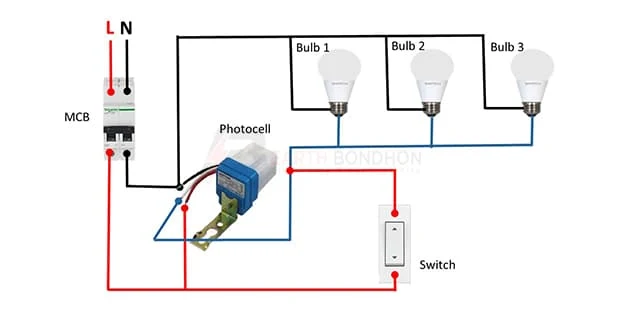Photocell sensor wiring:
Connect a black wire from the photocell to the black wire (N) from the building. A copper wire to make the connection tight. Connect the 2nd black wire (N) on the photocell to the black wire on the lamp. A wide range of photocells are available, but we'll discuss those most relevant to indoor and outdoor lighting.
Diagram of Install a photocell sensor wiring:
Components Need for this Project:
You can get the components from any of the sites below:
- DP MCB [See Buy Click Amazon]
- Photocell [See Buy Click Amazon]
- Switch [See Buy Click Amazon]
- Bulb [See Buy Click Amazon]
Read Also:
Components used to make the photocell sensor:
01. DP MCB
 |
| Fig 2: DP MCB |
Double pole MCB can control two wires. This circuit breaker is generally used in single-phase electric lines. Double pole MCB circuit breaker input has two wires supply two wires and an output. In a single-phase line, A double-pole MCB circuit breaker is used to give good production. This circuit breaker is provided through phase and neutral circuit breaker, it is very safe. This circuit breaker is preferred for home appliances. A DP MCB usually trips for 2 reasons 1. Overload 2. Short circuit.
02. Photocell
 |
| Fig 3: Photocell |
An Automatic Day Night Light Sensor Switch can Switch on Any Electrical Device Automatically When Dark Falls And Switch off in the Morning Automatically. This Night light With an Energy-Efficient LED (Light Emitting Diode) can be Plugged into the Socket and has a light sensor so that the lamp switches on automatically when it gets dark. This is a Photo Technology-Based automatic sensor switch for 220V AC mains, which can be Widely Used in Street Lights, Factories, Gardens, Shops, Etc., and Other Places for Automatic Lighting. Turns ON the Light in the Dark & Turns OFF in The Light.
03. Switch
 |
| Fig 4: Switch |
A Single-Pole, Single-Throw (SPST) Switch. It's Got one Output and One Input. The Switch will Either be Closed or Completely Disconnected. SPSTs are Perfect for on-off Switching. They're also a Very Common Form of Momentary Switches. SPST Switches are Commonly Used in a Variety of Electrical Circuits and Applications, Such as Turning on And off Lights, Fans, and Other Appliances. They can Also be Used to Control the Flow of Electricity to Different Parts of a Circuit or to Switch Between Different Circuits Altogether.
04. Bulb
 |
| Fig 5: Bulb |
CFLs work in a completely different way from ordinary lamps, they work by using a different process called fluorescence rather than generating light from heat. A typical light bulb wastes 90% of energy and converts only 10% of energy into light, this is where CFL has the biggest advantage. CFL- Curved or conical glass tube filled with argon and a small amount of mercury vapor. The inner wall of the glass is coated with fluorescent material. CFL- It is manufactured using the principle of creating fluorescent light. CFL- Originally white in color but now the construction and use of CFLs producing colored light has become popular.
Thank You for visiting the website. Keep visiting for more Updates.
Frequently Asked Questions
In this circuit diagram, we use a DP MCB ( Double Pole Miniature Circuit diagram Breaker ), a PIR Motion Sensor, a security light, and a switch. First, we need to input power connection to DP MCB, then input power to the motion sensor, then input connection to light and switch. Now this circuit is ready for use.
It is particularly useful for outdoor area lighting. Photocells are variable resistors that adjust the resistance in an electrical circuit diagram based on the level of light present in their mounted location. To function properly, they need to be placed in exposed power supply areas where they can receive sufficient current light.
A photocell and photoresistor is a sensor that changes its Circuit diagram resistance when light shines on it. The resistance generated varies depending on the light striking at the surface. A high intensity of light incident on the project system surface will cause a lower resistance, whereas a lower intensity of light will cause higher current resistance.
For most general applications the photocell should be mounted Circuit diagram between 6-8 feet of the window area, central to the area illuminated by the power supply electrical lighting that will be controlled. In all cases, the photocell must be mounted so that it looks at reflected light only and not at any direct current light.
A photocell and switch, also known as a photoelectric Circuit diagram sensor or photocell, does not typically require a neutral wire for its power supply operation. Photocell switches are used to detect the project system's presence or absence of light and can automatically control lighting fixtures.


Post a Comment
Do leave your comments